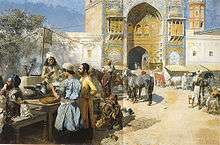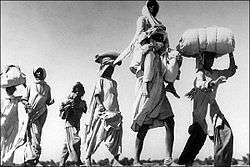Religion in Lahore
Before the independence of Pakistan in 1947, Lahore had sizeable minority of peoples belonging to faiths such as Buddhist, Hindu, Sikh, Christian and Jain residents but overall, the city had a Muslim majority. According to the 1941 population census, the total population of the Municipality of Lahore was 671,659, out of which Muslims constituted a majority of 64.50 per cent. Except for a small Christian community and some individuals from other minor groups, the rest were Hindus and Sikhs who together made up 36 per cent of the population. In the Lahore District as a whole the situation was similar. Muslims were 60.62 per cent while Hindus and Sikhs together formed 39.38 per cent of the population. The Hindus and Sikhs, however, owned the significant property in the city and in the district. According to the 1998 Pakistan population census, 93.9 percent of Lahore's population is Muslim, up from 50.1 percent in 1941. Other religions include Christians 5.80 percent (higher in rural areas where they form around 9.0 percent of the rural population) as well as Ahmadis at 0.20 percent and a small number of Bahá'ís, Hindus, Parsis, and Sikhs.
There were 300,000 Hindus and Sikhs living in Lahore at the time of independence of Pakistan in 1947. By August 19 (5 days after Pakistan's Independence) that number had sunk to 10,000, and by the end of the month to just 1,000. The majority moved to India.[1] Similar scale Muslim migration from nearby Amritsar in India occurred as well. The predominantly Muslim population supported Muslim League and Pakistan Movement. After the independence of Pakistan in 1947, the minority Hindus and Sikhs migrated to India while many Muslims refugees from India settled down in the Lahore.
There are many legends about the city of Lahore. While a focus for Islamic and Sufi thought, Lahore has historically been always been a traditional destination for those traveling along the ancient Silk Road or Middle Eastern and Central Asian caravans. It represented the final border between West, Central and South Asia. The city is also of significant importance to the Sikhs of Punjab region. The Sikhs still call it Lahore-Sharif.[2] [3] To the Muslims of Pakistan, Lahore represents a link to the Mughal and Sufi past. It is called the City of Data Ali Hujwiri (Data Ki Nagri), the Sufi who spread Islam to this corner of the South Asia..
Pre-Independence
Neighbourhoods

Some neighbourhoods of the city were entirely non-Muslim, others were mixed, while some were solely Muslim. Gumti Bazaar was an almost purely Hindu neighbourhood. Outside the gated city, other predominantly Hindu neighbourhoods included Krishan Nagar, Sant Nagar, Rajgarh (Kamni Kaushal lived here), Ram Galli, Nisbet Road, Qila Gujar Singh, Shah Alami and Gowalmandi, while the population of Beadon Road and Nicholson Road was a cosmopolitan mix. Ichhra and Model Town lay outside the city as it then was.
Ichhra, a Muslim-majority area, was said to be the original Lahore, the very site where the foundation of the city had been laid by Prince Lava, the son of the Hindu god Rama. Model Town was founded by rich and upper middle-class. Every house was fronted by a large lawn with lush fruit trees, especially ones that bore mangoes in summer. There was also a Model Town bus service that took people into the city, right up to Serai Rattan Chand, Gowalmandi and Shah Alami.
In British times, only a handful of Lahore's Muslims could be called affluent. Even in the Walled City of Lahore, most of the grand mansions or havelis belonged to non-Muslims, for example, Haveli Kabuli Mal, Haveli Dhyan Chand and Haveli Rai Diwan Chand. The only exception was Haveli Mian Khan, which was located between Rang Mahal and Mochi Gate. Mention, however, might be made of much smaller havelis owned by Muslims in the inner city. One was located in Mohalla Sammian. It was known as Haveli Judge Latif. The other was called Haveli Barood Khana where the family of Mian Amiruddin lived. It was located between Pani Wala Talab and Koocha Langay Mandi.
Business
Many of the non-Muslims who lived in the city traded in gold and silver, food grains and textiles, both wholesale and retail. Many of the moneylenders of Lahore were non-Muslim. Every business in Suha Bazaar, Machhi Hatta, Gumti Bazaar, Bazaaz Hatta and Shah Alami was owned by non-Muslims. Dabbi Bazaar had a number of small bookshops, mostly Muslim-owned. In the same Bazaar, Kashmiri Pandits who sold shawls and fine wool fabrics, could be found.[1]
Lifestyle

Morning in the inner city in those pre-1947 days began with the siren sounded from the North Western Railway loco shop and Makandri Lal's factory. The call to morning prayers was sounded from the city's many mosques, while bells would be rung in Hindu temples to begin morning worship. Makandari Lal's factory was located in Badami Bagh. Minto Park was where people took their morning walks and performed exercise. Cows and buffaloes were a common sight in city streets. Hindus respected the ox because they believed it to be Shivji Maharaj's mount. The cow was of course sacred to all Hindus. Sometimes these animals would become a nuisance, blocking traffic as they would decide to sit in the middle of the street. Some Hindu shopkeepers would place large slabs of rock salt on the street for animals to lick. The more devout Hindus had built water troughs here and there for these animals to drink from.
In all Hindu neighbourhoods, you found wedding halls called Janj Ghar, which were a boon for families that did not have the means to hold wedding ceremonies at home. While Hindu women did not observe the purdah as Muslim women did at the time but wore the traditional dupatta, unmarried Hindu girls were not allowed to apply makeup.
Whenever a Hindu funeral passed through the bazaar, Hindu shopkeepers would drop whatever they were doing, come down from their shops to stand on the street with their hands joined together in respect to the dead. When a Hindu died, his body was removed from the bed and placed on the bare floor, the belief being that if the dead person was left where he had died, his spirit would not leave the house. If a very old man died, his body was taken to the burning ground called Shamshan Ghat, led by a band playing merry music, including a popular movie hit of the time, Chal Chal re Naujawan (March on, march one, young man). Lahore's three or four shamshan ghats were located outside the city, one on the banks of the Ravi River. The remaining ashes which were called phool were placed in an urn and emptied into the Ravi River. The most famous shamshan ghat in the city was located beyond Taxali Gate.
Communal tensions
Communal tensions began to rise in the winter of 1945-46 when provincial elections were held. In March 1947 the first communal clashes took place in Lahore. When independence took place, a few months later in mid-August, Lahore had been emptied of almost all the Hindus and Sikhs. The demographic consequences of such change were indeed profound and everlasting. The departing Sikhs and to a lesser extent Hindus left behind many remnants – buildings, residential colonies and charitable institutions - that are reminiscent of their once very visible presence here.
As the banking capital of the British Raj, Lahore was the first area in which violence erupted as it was claimed by all ethnic groups. Communal tensions started in earnest following the provincial elections of 1945-6. Although the Muslim League achieved a majority of votes in the Punjab, they were unable to rule due to a cross party coalition.
Although non-Muslims comprised less than 40% of Lahore's population, they owned most of the property in the city and surrounding areas.
Reasons for violence
Some indicators of the reasons and levels of violence in Lahore follow:
- Poor British Colonial policing and improper planning for safe passage of refugees
- The decision by Khizr Tiwana to step down, in March 1947, first sparked violence in Lahore.
- Initially, the death of a Sikh constable was the trigger to communal violence and was blamed on the Muslim League.
- Hindu students clashed with police
- The above led to arson on Hindu businesses and violence against Sikhs.
- Rawalpindi massacre - non-Muslim communities in the area of Rawalpindi were attacked and killed.
- Leaders of the Indian National Congress advised Sikhs and Hindus not to leave Lahore, as a minority, so they were easy targets.
- Withdrawal of British administrators left a huge void.
- Whilst the majority of the middle classes managed to leave Lahore in safety, the lower classes were targeted as they could not arrange speedy departures from the city.
The result of the escalating violence in Lahore was the creation of refugee camps outside the city, holding around 40,000 refugees - mainly Sikhs. To the Sikhs the violence in the city had been orchestrated by both the Muslim League, and Punjabi politicians.
Independence of Pakistan

The announcement on 3 June 1947 placing Lahore on the west side of the boundary (effectively in the new Pakistan) led to an even greater escalation of violence in the area. Furthermore, the final boundary award confirming Amritsar to be within the borders of India was also the signal for massive genocidal conflict.
Present

According to the 1998 census, 94% of Lahore's population is Muslim, up from 60% in 1941. Other religions include Christians (5.80% of the total population, though they form around 9.0% of the rural population), and a small number of Bahá'ís, Zorastrian/Parsi, Buddhist, Hindus, and Sikhs.
Due to Lahore's diverse culture, there are many mosques, shrines, synagogues, Hindu and Jain temples, Sikh Gurudwaras, and churches across the city. Some of the most famous mosques include: Badshahi Masjid, Dai Anga Mosque, Data Durbar Complex, Shia Masjid, Suneri Mosque, Wazir Khan Mosque, Moti Masjid, Masjid-e-Shuhda (Martyr's Mosque) and Mosque of Mariyam Zamani Begum. Some of the famous shrines include: Tomb of Muhammad Iqbal, Bibi Pak Daman, Samadhi of Ranjit Singh, Tomb of Shah Jamal, Tomb of Lal Hussain, Tomb of Anārkalī, Tomb of Jahangir, Tomb of Empress Nur Jehan and Tomb of Abdul Hasan Asaf Khan. Some of the well-known churches include Regal Church, Hall Road Church, Convent of Jesus and Mary and Sacred Heart Cathedral. While Hindu temples and shrines have been targets of desecration, Sikh shrines in the city are generally well-kept, and those that are in disrepair are dilapidated due to lack of funds for upkeep - as opposed to Hindu places of worship that were actively destroyed and defaced.
References
- 1 2 LAHORE LAHORE AYE: Where Hindus and Sikhs once lived
- ↑ The foreign policy of Pakistan: ethnic impacts on diplomacy, 1971-1994 ISBN 1-86064-169-5 - Mehtab Ali Shah "Such is the political, psychological and religious attachment of the Sikhs to that city that a Khalistan without Lahore would be like a Germany without Berlin."
- ↑ Amritsar to Lahore: a journey across the India-Pakistan border - Stephen Alter ISBN 0-8122-1743-8 "Ever since the separatist movement gathered force in the 1980s, Pakistan has sided with the Sikhs, even though the territorial ambitions of Khalistan include Lahore and sections of the Punjab on both sides of the border."